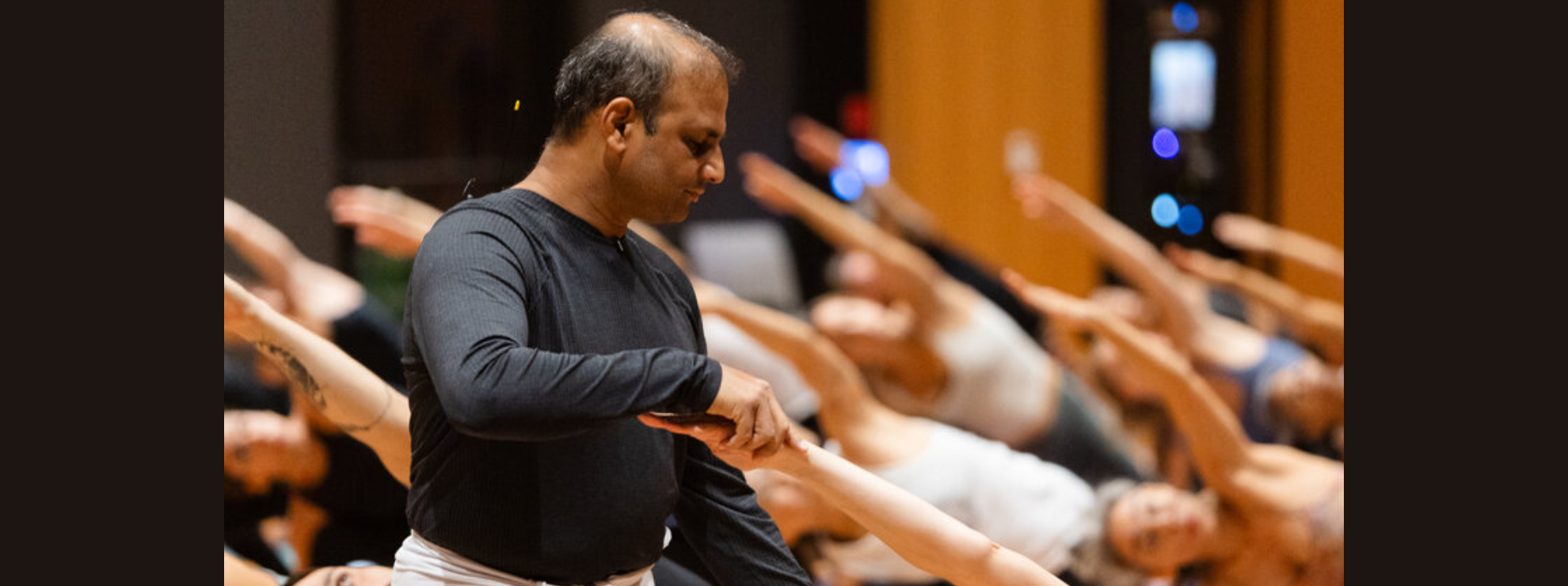(December 7, 2024) At 3 am every day, as Mysuru slept, 19 year-old Sharath Jois would ride through the deserted streets to his grandfather’s house to practice yoga. His grandfather and guruji was the legendary Shri Pattabhi K Jois, the founder of Ashtanga Yoga, one of the teachers who took yoga from the confines of a small group of gurus and disciples to the world, a mission that Sharath continued to fulfil until his death. The Global Indian, who passed away in November 2024 at the age of 53, had dedicated over 30 years of his life to carrying on his grandfather’s storied legacy, training thousands of students and teachers around the world. Today, over 300 million people worldwide practice yoga, and the Jois legacy has been instrumental in making this happen.
Back in 2017, when International Yoga Day was just becoming a global phenomenon, a colleague, who happened to be from Mysuru, gave me Sharath Jois’ phone number. An long-time practitioner of yoga myself, I was thrilled at the opportunity to interview the legend. That evening, Sharath told me how yoga became a rage around the world. In 1941, Wallace Kirkland, a photographer for Life Magazine, was on a six month visit to explore the “museum of human achievement and eccentricity that is India.” Passing through Mysuru, he came across a group of young yogis in the middle of an advanced yoga practice with their guru.
Kirkland’s photographs were published in Life in February, 1941, and spread like wildfire. Before these austere, unassuming yogis could process the fame that was thrust upon them, “people were flocking to the shala from all over the world,” Sharath told me, in an interview for the Deccan Chronicle. Pattabhi Jois had passed away in 2009, and Sharath, who had adopted the title of Paramaguru or lineage holder, had inherited his grandfather’s Ashtanga Yoga Research Institute. In 2019, he set up the Sharath Yoga Centre, where he went on to train yoga teachers and practitioners around the globe.

Sri Pattabhi Jois in Life magazine, photographed by Wallace Kirkland. Photo: Deccan Chronicle / Life
The birth of a legacy
Sharath Jois’ story is the story of Ashtanga yoga, and it begins with his grandfather, Shri K. Pattabhi Jois. The older Jois was the son of an astrologer, and had grown up learning Sanskrit and Hindu rituals at a very young age. “He was 12 years old when he met Krishnamacharya for the first time,” Sharath said. Tirumalai Krishnamacharya, now called the Father of Modern Yoga, is regarded as one of the most important gurus of yoga as we know it today, and is credited with the revival of hatha yoga.
For Shri Pattabhi Jois, yoga was an instant calling. “He went up to him (Krishnamacharya) immediately and asked if he could be his student,” said Sharath. “He would travel to Hassan everyday for his practice.” Shri Pattabhi Jois dedicated his life to teaching yoga, as did his fellow student, BKS Iyengar.
Those were not easy days. “Finding students was very difficult at the start and grandfather would go from house to house and across the Sanskrit College campus, asking people to join his class,” Sharath recalled. Life changed all that. They soon had to move out of the small shala in Lakshmipuram and set up a bigger space in Gokulam, which soon ran out of space also.

Sharath Jois with BKS Iyengar and Sri Pattabhi Jois
Sharath Jois’ trial by fire
“As a child, I was always ill,” he writes in his book, Ageless: A Yogi’s Secrets To A Long And Healthy Life (Juggernaut Books, 2018). “My early years were racked with pain. Tonsilitis, rheumatic fever and infections from the fever… you name it, I had it.” He couldn’t do anything his friends did, including riding a cycle. And when he was 11 years old, an illness dashed his dreams of becoming a professional cricketer. “I spent months in bed,” he writes. “I was diagnosed with a rare illness called rheumatic fever, which can take anywhere from five to ten years of antibiotic medication to heal completely.”
However, he had begun practicing yoga at the age seven, and would go reluctantly to the shala wishing he could play cricket instead. “I would run out the back door and go play cricket with my friends,” he laughed, recalling those days in an interview. “My grandfather would come searching for me, and my friends would warn me, so I would run and hide until he went away!”
In retrospect, he admits that those early days of yoga may have saved his life. “Yoga with my grandfather changed my health for the better. Instead of a decade of antibiotics, a series of very simple postures helped me become stronger. I could feel my body heal and repair.” Even doctors said his recovery was a miracle, because his body had been so badly weakened by illness after illness. “Later, I would learn that the ‘miracle’ was not mystical, it was simply the result of the practical and logical yogic practice to which my grandfather introduced me,” he writes in Ageless. This realisation would go on to become one of the cornerstones of Sharath’s own teaching, which is rooted in the teachings of the Yoga Sutras of Patanjali, and focussed on the breath as the centre of the asana practice. Like his grandfather, Sharath would also immerse himself in the study of the eight limbs of yoga, Vedic knowledge and Ayurveda, which is how he presented yoga to the world.
When yoga became a calling
Sharath was 19 years old when he began taking yoga seriously. His maternal grandparents were managing the show alone at the shala and his mother would urge him to go help out. “I would keep putting it off until one day, I decided to go. That’s how it began.”
He had great passion for yoga, and the best teacher, but when he got a job at an electronics company in Bengaluru, he was tempted to take it. His grandmother encouraged him to turn it down and continue training in yoga. She passed away in 1997, the year Sharath began travelling the world with Shri Pattabhi Jois. “In December 1996, after having been denied a visa thrice, I finally travelled abroad for the first time, to Sydney,” Sharath writes. “Soon after that, my grandfather and I visited the US a few times.”
With this wave of popularity, more students began coming to the Shala in Mysuru. After the Americans came Europeans, followed by Japanese and Chinese. Sharath himself was doing “demos from Japan to Chile,” as his grandfather led the counts and he demonstrated the postures.

Taking Ashtanga to the world
By the year 2000, Ashtanga Yoga “started gaining popularity at a phenomenal pace” and Sharath was doing demos around the world with his grandfather. However, he was surprised to learn that people had no idea where yoga came from – many thought it came from America! Sharath saw it as his duty to set this right. “Yoga is Bharat Bhumi. Just one look at Indian history and you will see how even before India was India, people came here from all over the world to learn yoga.”
Celebrities like Gwyneth Paltrow and William Dafoe were doing Ashtanga yoga and became advocates of the method. “Paltrow practiced with Guruji when we visited New York in the aftermath of 9/11. At this time in American history, Ashtanga became a release and a powerful healer for Americans,” Sharath writes.
Today, social media is full of fitness stars, contorting themselves into fantastic postures, and providing 15 second preps for handstands (adho mukha vrksasana), rather than the gradual seeking of the Vinyasa Krama. Just as his grandfather brought breathing to movement, Sharath worked to bring this ancient practice back to its spiritual roots, rather than the acrobatic and spiritual showboating that is so common among yoga influencers.
Taking over the Jois legacy
In 2007, Sharath Jois took over his grandfather’s yoga institute, and after Shri Patabbhi Jois died two years later, he renamed the organisation in his honour as the K. Pattabhi Jois Ashtanga Yoga Institute. In 2019, his mother became its leader and Sharath set up his own company, the Sharath Yoga Center. As of 2022, the students and shalas of K. Pattabhi Jois Ashtanga Yoga Institute are situated in over 100 countries around the world. As of 2022, the students and shalas of K. Pattabhi Jois Ashtanga Yoa Institute are situated in over 100 countries around the world.
View this post on Instagram
An untimely death
Towards the latter half of his life, Jois spent the better part of the year travelling, and his workshops, held in Mysuru and around the world, were attended by thousands of disciplies. In November 2024, Sharath was at the University of Virginia and, during a hike with his students near the university campus in Charlottesville, began complaining of fatigue. He sat down on a nearby bench and toppled off it. His students attempted to revive him and he was declared dead moments after the emergency service arrived.
The Jois family legacy will now be carried on by the thousands of disciples who went on to become teachers under the tutelage of Sharath Jois. “The crowd was growing every year,” Isha Singh Sahwney, the co-author of Ageless: A Yogi’s Secrets to a Long and Healthy Life, told the New York Times. “He was an excellent yoga teacher, one of the best. At the time of his death, Jois was scheduled to teach workshops in San Antonio, Sydney and Dubai and was also working on his second book.
An immortal legacy
Until the end, he maintained the life of piety and discipline he had learned from his grandfather. His day would begin at 1 am, for two hours of personal practice, followed by six hours of teaching. And while he received great admiration, he shied away from it. “He didn’t want to be this god figure,” Sahwney said. “He just wanted to teach yoga and spread the message of yoga.” Sharath himself would joke, in fact, when his admiring disciples asked questions about spirituality. “These days it’s fashionable to offer Pranayama and even Samadhi in the form of a certificate! People like to say, yes, I have achieved Samadhi, look it’s on this certificate. It’s a good way to make a living, but it won’t make you a yogi.”





